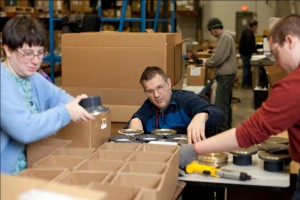October 12, 2011
by: Renee Canfield
It’s What an Employee CAN Do That is Important!
 Every day, people with disabilities can and do add value to America’s workplaces. However, in both good economic times and bad, people with disabilities have far fewer job opportunities than the general population.
Every day, people with disabilities can and do add value to America’s workplaces. However, in both good economic times and bad, people with disabilities have far fewer job opportunities than the general population.
By fostering a culture of diversity, or a capacity to appreciate and value individual differences, in all aspects of their operations, employers benefit from varied perspectives on how to confront business challenges and achieve success. Although the term is most often used to refer to differences among individuals such as ethnicity, gender, age and religion, diversity actually encompasses the infinite range of individuals’ unique attributes and experiences. As the nation’s largest minority — comprising almost 50 million individuals — people with disabilities contribute to diversity, and businesses can enhance their competitive edge by taking steps to ensure they are integrated into their workforce and customer base.
In the Workforce 
Employers have much to gain by having a workplace that is open to everyone. Such universal thinking not only helps recruit skilled employees, but also enhances corporate continuity efforts by helping employers retain the talents of an aging workforce. And when it comes to doing business, being inclusive of people with disabilities—in recruitment, retention and advancement—can offer companies a competitive edge. People with disabilities are known to be experienced problem solvers with a proven ability to adapt. What’s more, they mirror an important and increasingly expanding customer base. This untapped labor pool can offer a source of skilled employees and can contribute to increasing retention and reducing turnover. In addition, tax incentives and technical assistance can assist with accommodations, which are often relatively easy and inexpensive to implement. To gain these benefits and others, employers should take steps to attract and retain employees with disabilities, such as:
- Seeking out qualified candidates with disabilities for job openings
- Establishing a system for educating all workers about the value people with disabilities bring to an organization
- Incorporating a disability focus into any diversity training program
- Ensuring that internal professional development programs are available to people with disabilities
- Providing employees with disabilities with candid and prompt feedback on their performance in the same manner as provided for individuals without disabilities
- Making certain that training and other off-site activities are accessible to employees with disabilities
- Taking advantage of tax credits and education resources to provide accommodations for both new employees with disabilities and employees returning to work following an illness or injury
- Hire individuals with disabilities based on their skills and what they can offer your talent pool, not just because they have a disability–
Remember, It is What an Employee CAN DO that is important!
In the Marketplace
A business’ commitment to diversity is also reflected in its customer base, and companies are beginning to recognize the value of people with disabilities as a target market. Organizations such as the National Organization on Disability estimate that Americans with disabilities represent more than $200 billion in discretionary spending — not including their extended families and support networks, who are also a significant market segment. When deciding how to spend this money, individuals with disabilities have the same standards as all customers — they want quality products and services at competitive prices. To tap this market, businesses should take steps to ensure their marketing efforts convey that people with disabilities are valued as customers. Such steps may include:
- Incorporating people with disabilities into the business’s marketing strategy
- Testing proposed marketing tactics among people with disabilities
- Implementing promotional tactics specifically targeted to people with disabilities
- Ensuring that communication channels for advertising and promotion reach people with disabilities
- Incorporating people with disabilities in advertising and other promotional activities
- Recognizing that the disability market is a diverse one in and of itself and that one size does not fit all
- Defining how and why the disability market needs the business’s products and services
- Including people with disabilities in product development, keeping in mind that products created to the meet the needs of people with disabilities often turn out to have widespread applicability
- Devising simple modifications to make existing products and services accessible to people with disabilities
Resources to Assist
Building partnerships is critical to incorporating individuals with disabilities into diversity goals, and a number of resources are available to help employers in their efforts, including:
UCP of Greater Cleveland, Community Employment Program
UCP of Greater Cleveland, Community Employment Current Applicant Pool List
What Can You Do Campaign–Great resources for employers on best practices for hiring qualified individuals with disabilities
U.S. Department of Labor, Office of Disability Employment Policy–ODEP is a U.S. Department of Labor agency that provides national leadership to increase employment opportunities for adults and youth with disabilities
Ohio Governors’ Committees on Employment of People with Disabilities–State committees on employment of people with disabilities can provide guidance to employers on how to recruit and retain qualified individuals with disabilities

Leave a Reply